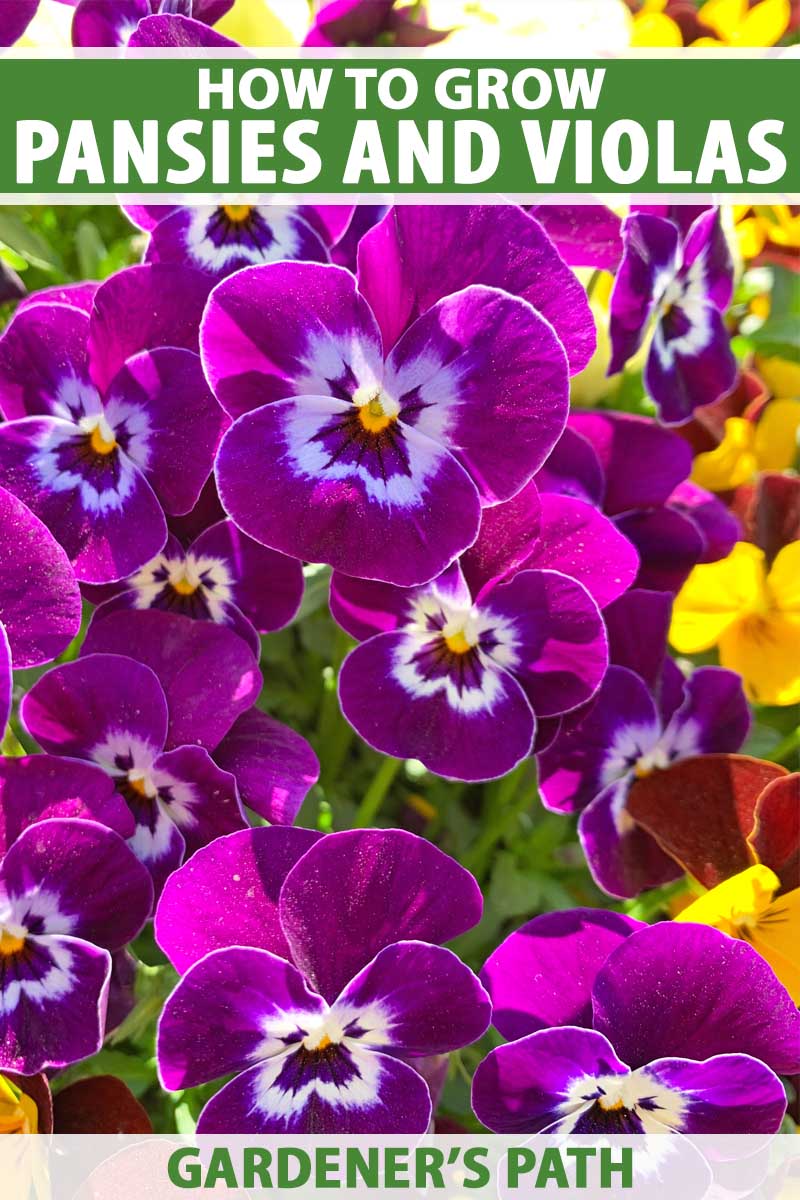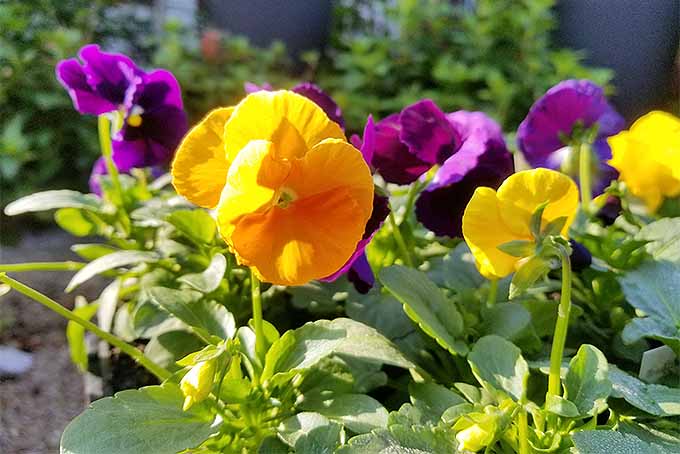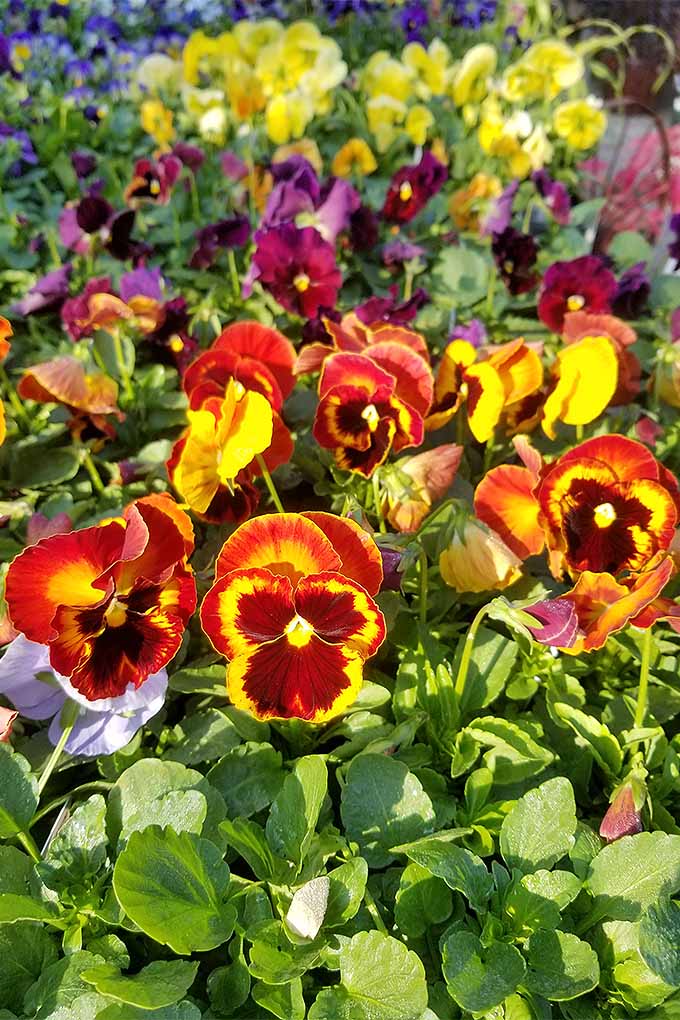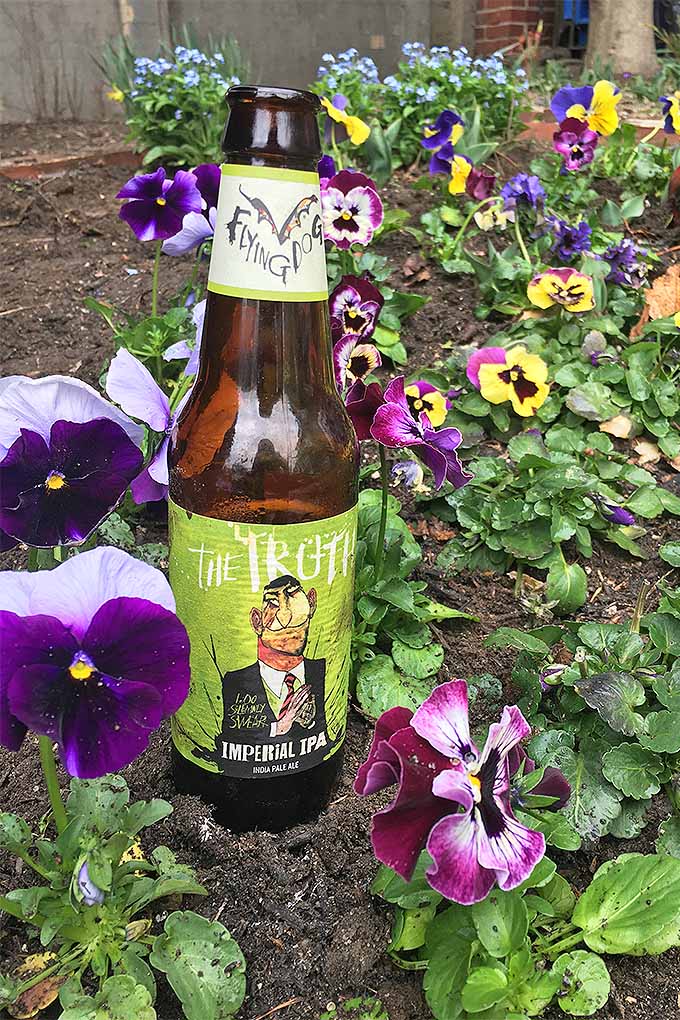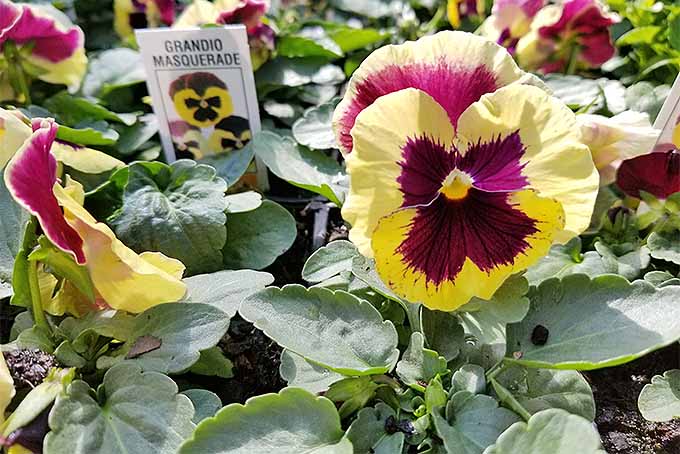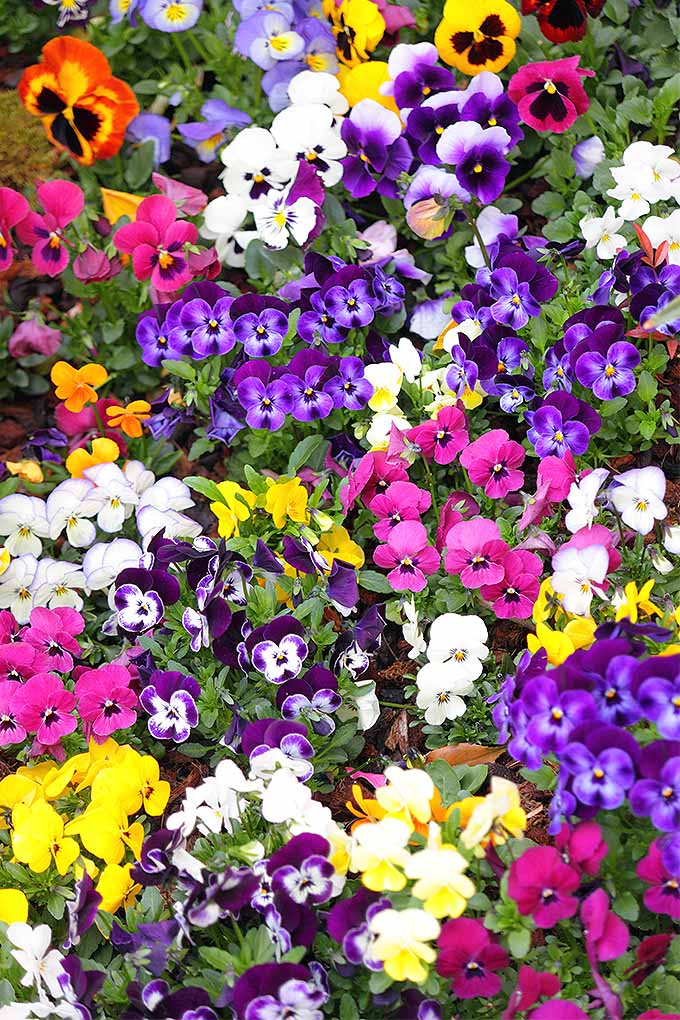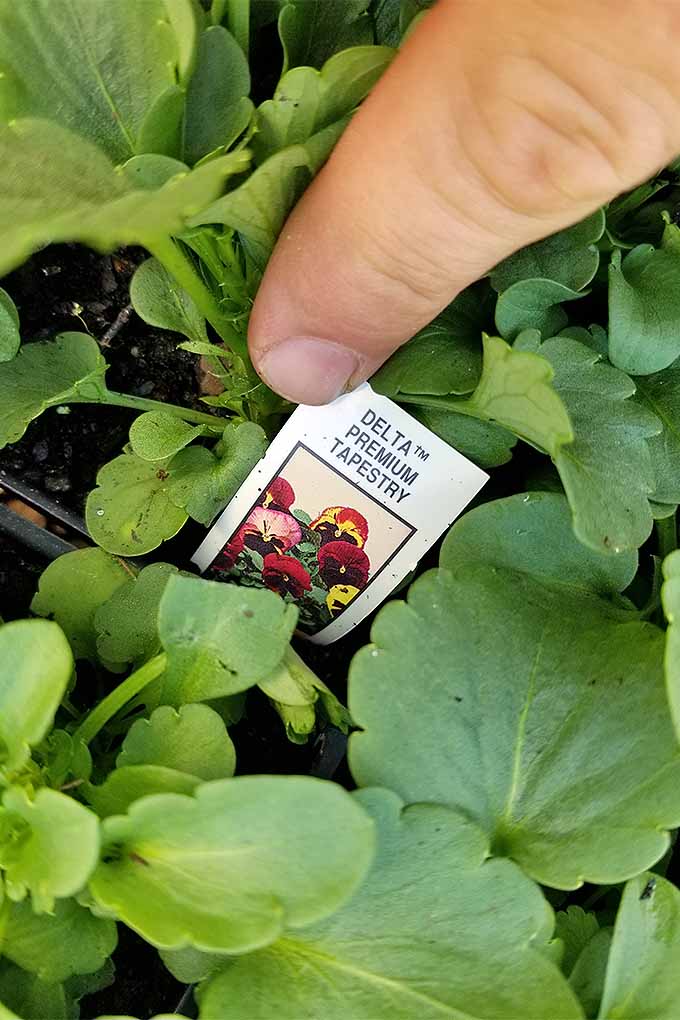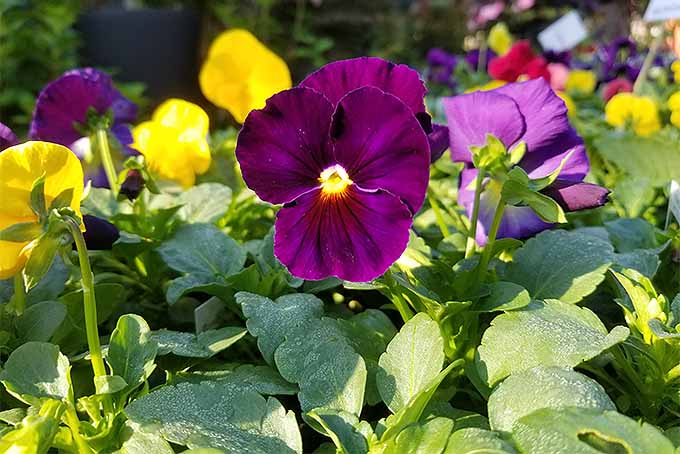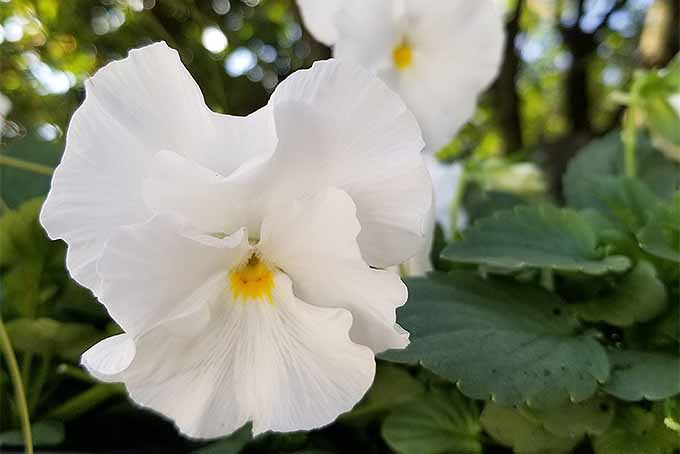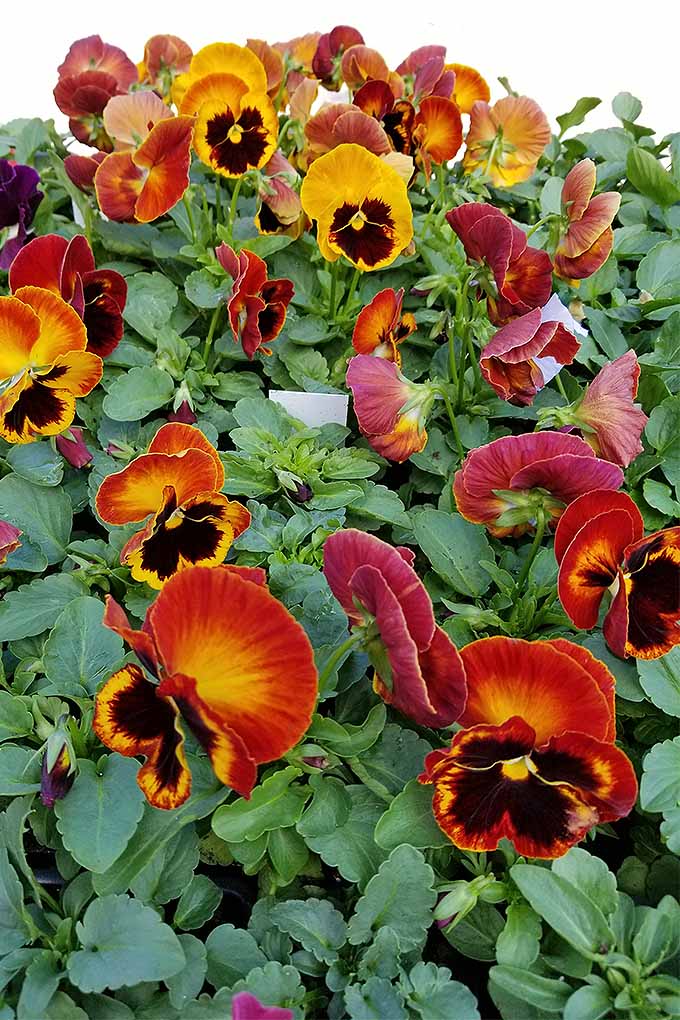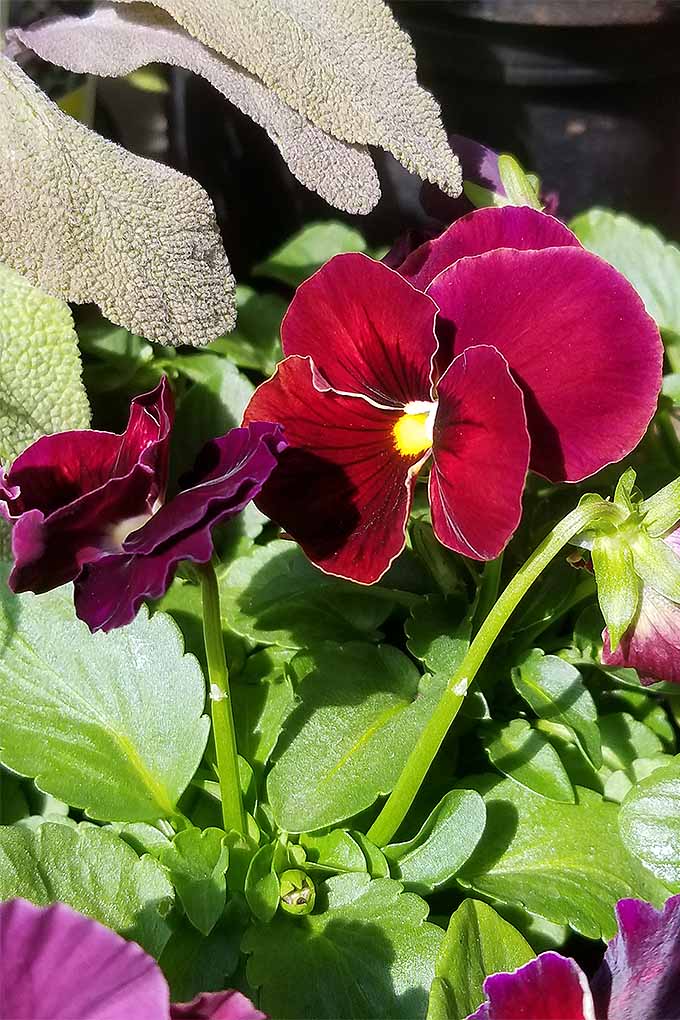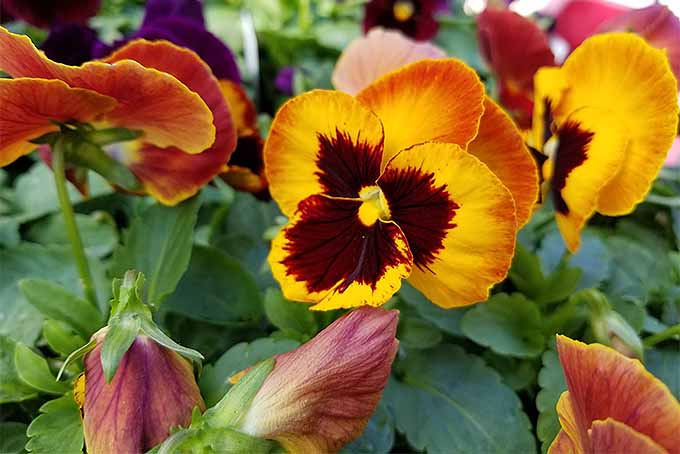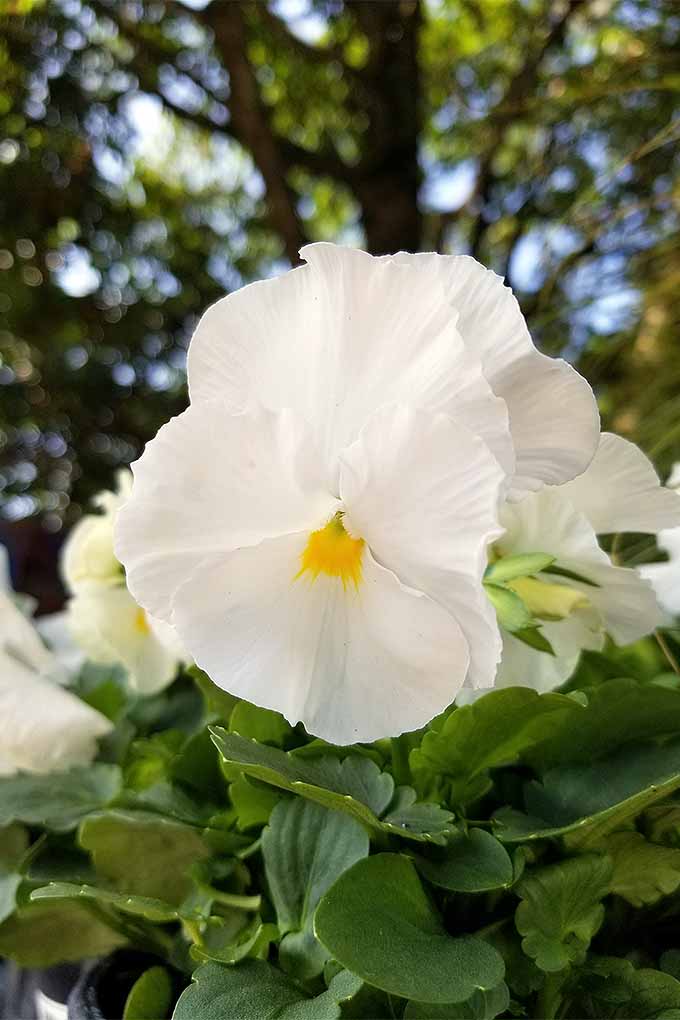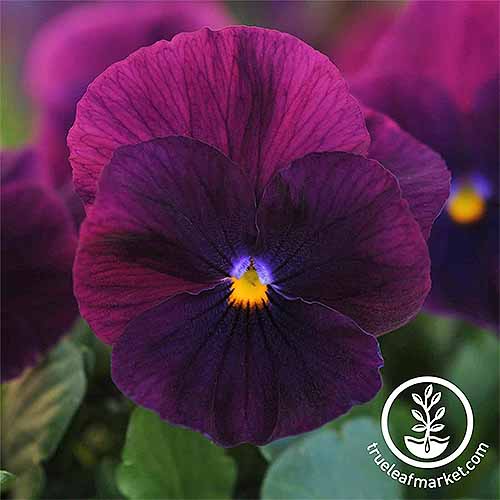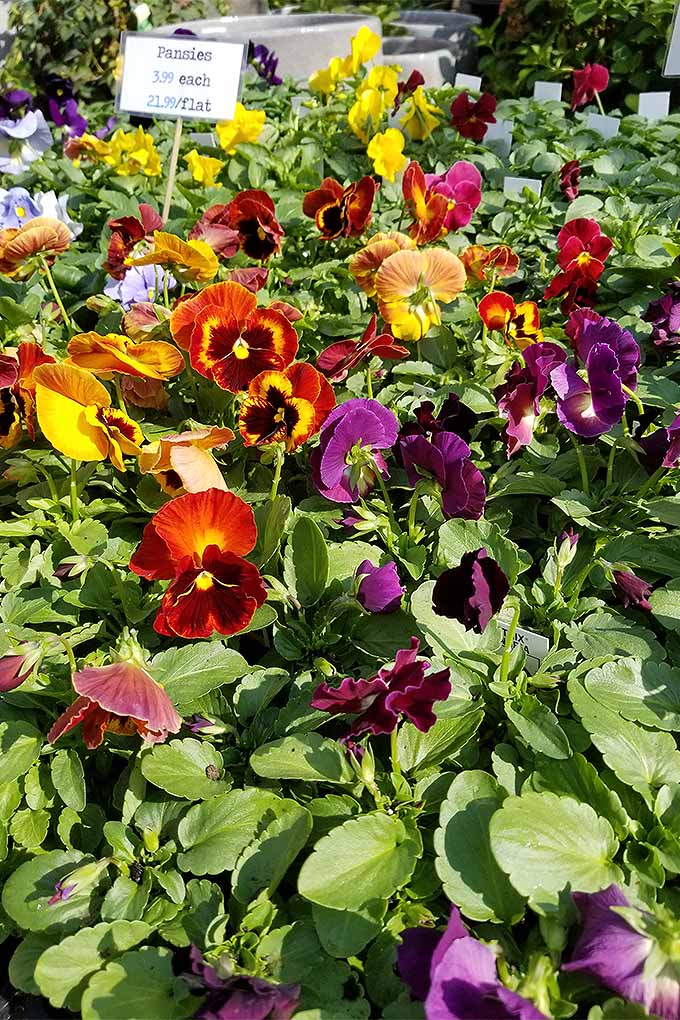My fiance loves colorful flowers. The brighter the better, she’d tell you. I’ve always tried to work with a specific palette of color to ensure a nice cohesion to landscape design. She, on the hand, wants pinks here and bright oranges in the corner, and don’t forget yellow and red in the middle. When we bought pansies for the front garden, the first garden we planted together, we had a difficult time finding enough identical colors in the quantities we needed. So our first garden became a kaleidoscope, a dizzying array of two-toned flowers that we mashed together. It looked like somebody dropped a few dozen 64-pack boxes of Crayola crayons in the yard. We link to vendors to help you find relevant products. If you buy from one of our links, we may earn a commission. It’s the best garden I’ve ever planted, and I owe it all to the pansy.
A Short History Lesson
The pansy gets its name from the French word pensée, or “thought.” So wrinkle that brow and get ready to jump into some learnin’! Pansies are almost universally known as either “pansies” or “violas.” Modern-day pansies trace their origin to the European flower Viola tricolor, a wildflower that has since been introduced into North America where it has taken hold as a common sight in lawn and field. It’s easy to see the similarities between a viola and a pansy, but there’s one surefire way to distinguish them from each other: If the flower has four petals facing upward and one petal facing downward, you’re looking at a pansy. If the flower has two upward-facing petals and three facing downward, it’s a viola. Take that little tidbit to your next garden club meeting. The staggering array of colors and patterns available in pansies today can be traced back to wealthy landowners and their trusted gardeners. Lady Mary Elizabeth Bennet of Surrey in England sought to collect and cultivate every type of V. tricolor in her garden that she could get her hands on. Her gardener, William Richardson, convinced her to cross-breed the superb collection of flowers. By 1812, the flowers were introduced and other gardeners took a stab at further cultivars. At about the same time, James, Lord Gambier and his gardener, William Thompson, crossbred their own specimens. Thanks to the combined efforts of landowners and their smooth-talking gardeners, by 1833 there were over 400 new species of V. tricolor available, with their own cultivar names.
The Truth About Pansies
I do love to drink a tasty beer while I’m gardening at home, and I think a little bit of Truth goes a long way when we’re talking about the uses of pansies. The great appeal of absorbing yourself in the world of plants is that there’s always something new to learn. For example, this article you’re reading right now is about how to plant and care for pansies. However, in my research, I learned some surprising insights on V. tricolor. First off, these guys are edible. That’s pretty great in and of itself. You can see colorful pansies used to decorate cakes and salads, and they’re used to infuse honey with particular flavors. Think of that pansy bed as a fall and springtime nasturtium replacement. We recommend only eating flowers from your garden that have been grown organically, and take it easy when adding them to your salads and desserts, in case of possible allergies. To add pansy flowers to your meals, simply pluck off the flowers you like and add them to the dish. Be mindful of insects and other undesirables. It should be standard practice to rinse off anything from your garden before eating it! Traditionally, V. tricolor has been used medicinally as well. The mucilage found in the plant provides treatment for rough coughs by soothing mucous membranes. It’s been used to treat respiratory problems, asthma, fever, and constipation, among other ailments. Some sources claim it can be used to treat skin wounds and psoriasis. If you’re going to ingest your pansies, be diligent on what types of fertilizer you are using. Carefully read the labels of all fertilizers, mulches, and other accessory products used in your garden beds.
Care and Maintenance
Delightful and prosperous in the right conditions, these flowers require some basic preparation and site maintenance to thrive. They also suffer from a number of diseases and pests, but a little knowledge goes a long way in preventing these conditions. It bears mentioning right off the bat that pansies fare exceptionally well in containers, because this eliminates the usual source of problems while providing all of their favorite conditions.
Starting Things the Right Way
Chances are you’re going to be starting in a garden center or perhaps shopping online when planting pansies. This is where it all begins! There are three rules for buying almost any landscape flowering plant, and they all apply to purchasing the pansy. Luckily, they’re all super simple. Here’s what to look out for: Now that you’ve picked up your plants, let’s look at their new home. Most attendants at the plant nursery are happy to answer your questions if you have any about the health of a plant.
2. Strong Roots
Although it can be difficult to inspect the roots, it’s not impossible. Give the stem of the plant a gentle tug, as if you’re removing it from its container. If the plant threatens to pop out of the soil, it’s too weak, and if the whole cell slides out, you’re looking at a rootbound plant. Just like Goldilocks, you want the plants that are somewhere in the middle, with roots that are just right.
3. Buds
It’s tempting to buy the plant with the flashiest flowers right now, but hold off on that and find a plant with plenty of buds instead. Those buds will open up into new flowers in a few days or weeks and provide you with lasting color, whereas the flowers already in bloom at the garden center are likely to wither away shortly after you get home.
Fall is the best time of year to plant a pansy. The cooler temperatures and less intense light enable the plant to establish healthy roots to survive the winter months. Although they’ll grow in conditions with less light, the pansy prefers a solid 6 hours of sunlight or more to prosper. Consider planting V. tricolor in an area where you have spring bulbs. The variety of flowers will all bloom at the same time and provide a brilliant display of springtime color. Like many plants, the pansy requires well-drained soil. If you have a slightly elevated bed, ideally around 6 inches higher than grade, you’ve got an ideal situation for growing V. tricolor. Amend the soil with good quality compost to aid in drainage. Many communities offer free compost; it makes fall and spring leaf cleanups a breeze when homeowners return the leaves as compost! If planted en masse in a bed for a real pop of color, maintain a distance of 6 to 10 inches between plants to aid in air circulation. If you are the indecisive type, plant them 8 inches apart! A.M. Leonard Classic Stainless Steel Soil Knife You know that feeling you get when you get a new haircut? It’s refreshing, isn’t it? The pansy responds the same way to getting a haircut. Deadheading only takes a few minutes and these flowers will respond with glowing color. When growth gets leggy, it’s beneficial to bring out a pair of shears and give them a good haircut to encourage new growth. For the best blooms, fertilize regularly. Every two weeks is a good schedule during the fall and spring growing seasons. I recommend Jack’s All-Purpose Fertilizer for just about anything in your garden. If you prefer a slow-release organic fertilizer, use Espoma Plant Tone, my other go-to choice. When fertilizing, it’s wise to wet the soil around the plants before applying a liquid fertilizer. This allows the nutrients to be absorbed more quickly by the plants and prevents runoff. If you’re using a granular or slow-release fertilizer, do this the other way around. That is, apply the fertilizer to dry soil and then water it in.
4. Cold Weather Care
Pansies share a similar tenacity towards cold weather but a closely related species, the winter pansy (Viola hiemalis), is partcularly hardy. As a rule of thumb, the larger the flower on a pansy, the less likely the plant is to overwinter well. Read more about overwintering pansies here.
Pests and Other Concerns
For all of those great shows of color, the pansy also invites its share of trouble. But like most things in life, a little diligence by way of prevention can stop a problem before it starts. Aphids, the pansy worm, cutworms, and the slow creeping march of slugs all plague V. tricolor. Regular insecticidal soaps will assist in preventing infestations, and in removing problems. The best method to preventing these pests from becoming a problem is to maintain a watchful eye on the health of your plants. Kill two birds with one stone by inspecting plants for pests while deadheading. You’ll save time and help keep those blooms in tip-top shape. Root rot and downy mildew are the biggest concerns for pansy health. These are situations easily avoided by maintaining a healthy watering schedule and by carefully selecting where your plants will be established.
The Passing Seasons
A brilliant display of flowers while they are becoming established in the fall is hyphenated by the winter cool-down. Pansies will survive in the cold and the snow with little more than a stiff upper lip turned towards ol’ Jack Frost. Frozen winter days are when I consider watering my pansy bed with whiskey because they’re John Wayne tough. Pansies will survive through most single-digit weather and can have snow and ice dumped on them. However, if you want to guarantee their survival, consider giving the plants a good watering before a hard freeze to protect the roots. Pine straw is an excellent choice for mulching your pansy bed for added protection from the onslaught of winter. Personally, I say, leave ‘em be. Pansies will pop up and smile at the sun during warm winter weather. Why cover up and potentially minimize that rare flash of winter color? The arrival of spring provides a good opportunity to give the plants a quick cleanup, but then brace yourself for that color explosion. Springtime is when these guys really shine. Unfortunately, the hotter it gets, the weaker pansies perform. They are simply not cut out for warmer weather, and even specific cultivars bred for this purpose tend to winnow out when temperatures climb in June and July. My own bed was completely dried up and withered by the Fourth of July. But you may find more success and a longer season in cooler climates.
A Closer Look at Cultivars
Working at a garden center allowed me to learn the names people prefer to use for their plants. It led to many a confusing interaction – imagine being asked for “chlamydia” when the customer meant “clematis”. Believe me, it’s happened more than once. We’re going to look at a handful of cultivars available below.
Colormax
A reliable and hardy flower, the Colormax series offers a viola with a larger flower. Rivaling pansies in size, it can handle winter cold and sudden spikes of warmth through the fall and into early summer.
Delta
My favorite style of pansy, the Delta offers a tremendous variety of color in a plant that’s capable of taking some serious punishment. The flowers are almost constantly in bloom and offer a wide enough selection that even the most picky gardener can find something suitable. These flowers tend to be smaller than other types.
Matrix
The Matrix varieties have the most interesting colors, as far as I’m concerned. The one pictured here is ‘Solar Flare’, and if that’s not a punchy and vibrant color, then I don’t know what is! The Matrix cultivars about as hardy as the Delta series.
Mammoth
It’s all in the name with this one. The Mammoth provides some massively-sized flowers with a respectable assortment of colors to choose from. Although you’ll receive huge flowers from the Mammoth series, keep in mind that they are also less hardy against cold winters.
Where to Buy
Though you local nursery is likely your best bet for pallets of pansies that are ready to put into your containers or the ground, if you’re willing to start from seed, a variety of options are available to you. We love the variety offered in the Cool Wave Series, available from True Leaf Market. You can choose from packs of 100 seeds in Frost, Golden Yellow, Violet Wing, Purple, or mixed packages. Pansy Cool Wave Series in Purple This vigorous spreading variety is excellent for hanging baskets and ground covers, and it boasts excellent overwintering hardiness with two-inch blooms.
Put Your Knowledge to Work for Enjoyment Through the Seasons
Planting pansies is one of my favorite gardening traditions, coupled with enjoying throughout the colder seasons and again in the springtime sun. They are an excellent flower for novices and experts alike to liven up their yards and porches. Be sure to check our two supplemental guides: “19 of the Best Pansy Varieties to Grow at Home” and “39 of the Best Violet Varieties.” Now, if you’ll excuse me, I’m going to run to the store and buy my usual motley array of colors and get to planting. I’ll see you out there! Do you have any pansy memories you want to share, or questions about planting these lovely flowers? Ask us here in the comments, or feel free to connect with us on the Gardener’s Path Facebook page or Twitter! Looking for more flower guides? Here are a few suggestions:
Tips for Growing Violets, Violas, and Pansies IndoorsHow to Grow Joe-Pye Weed in Your Landscape or GardenHow to Grow Hardy Fuchsia Shrubs in the Home Garden
Photos by Matt Suwak. © Ask the Experts, LLC. ALL RIGHTS RESERVED. See our TOS for more details. Product photos via A.M. Leonard, J.R. Peters, Espoma, True Leaf Market. Uncredited photo: Shutterstock. The staff at Gardener’s Path are not medical professionals and this article should not be construed as medical advice intended to assess, diagnose, prescribe, or promise cure. Gardener’s Path and Ask the Experts, LLC assume no liability for the use or misuse of the material presented above. Always consult with a medical professional before changing your diet or using plant-based remedies or supplements for health and wellness.

